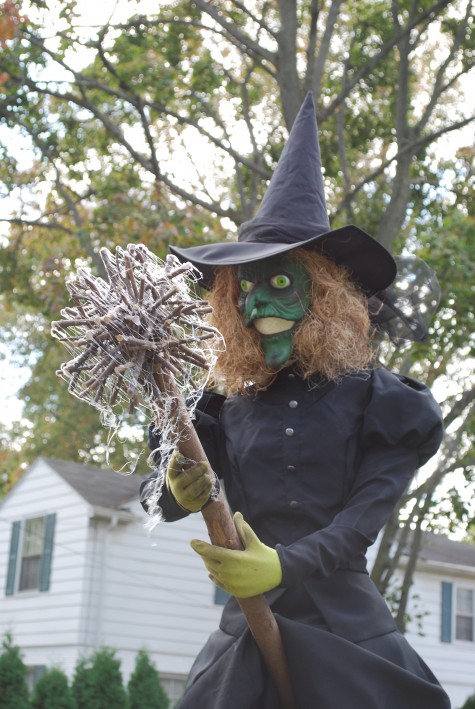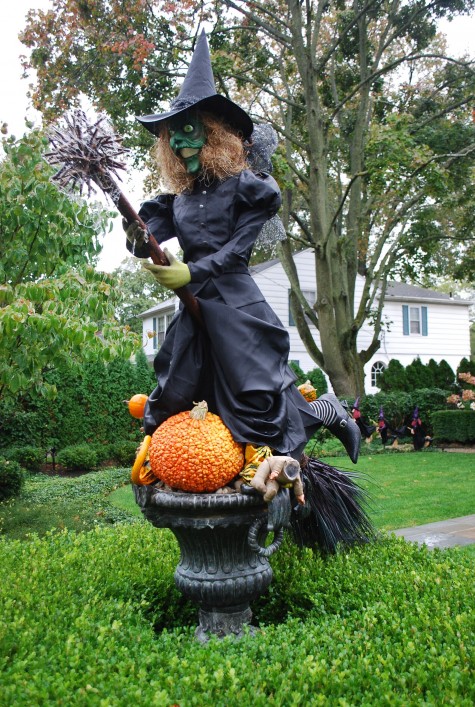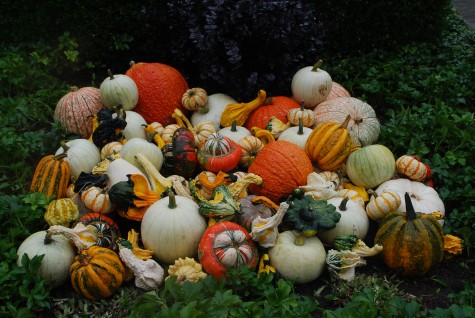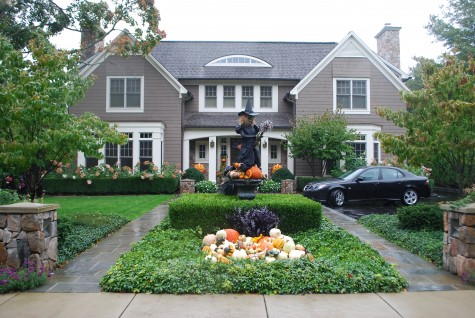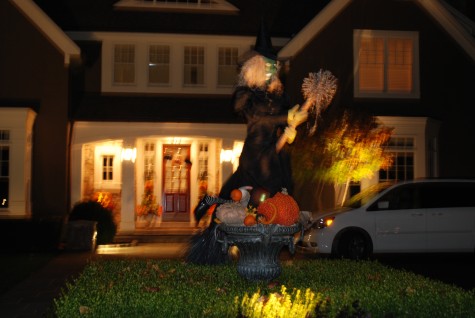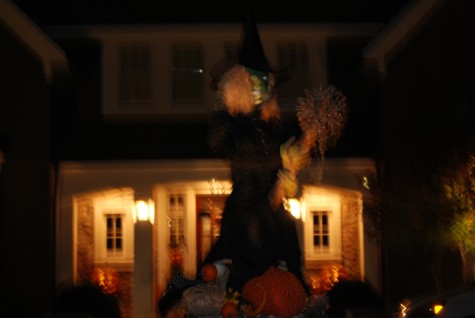Archives for October 2010
At A Glance: The Witch Is In
Have A Horrible Holiday
 I do have a horribly soft spot for the Halloween holiday. As much as the gardener in me loves the colors, varieties and shapes of the squash and pumpkins that come to market in the fall, I especially relish the ritual carving of these large roundish fruits into faces of all kinds-silly faces, spooky faces, the faces of the dead, damned and long suffering, the terrifying faces, the simply terrified faces. A client who needed a number of fanciful carved faces-how could I speedily scoop and carve? Though I love my dremel tool, its grinding wheel coated me in pumpkin juice and bits in seconds. I needed a time out to wash my windshield.
I do have a horribly soft spot for the Halloween holiday. As much as the gardener in me loves the colors, varieties and shapes of the squash and pumpkins that come to market in the fall, I especially relish the ritual carving of these large roundish fruits into faces of all kinds-silly faces, spooky faces, the faces of the dead, damned and long suffering, the terrifying faces, the simply terrified faces. A client who needed a number of fanciful carved faces-how could I speedily scoop and carve? Though I love my dremel tool, its grinding wheel coated me in pumpkin juice and bits in seconds. I needed a time out to wash my windshield.
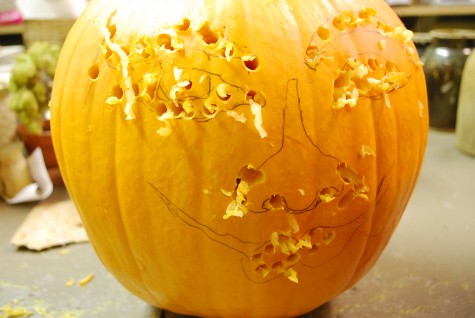 My battery operated drill was a lot more friendly. After a ink sketch on the pumpkin rind, I drilled holes in every spot I neede a curve. A florist’s knife is sharp as heck, but generating curves with a straight blade on a curved surface-a blisteringly difficult job. Any child would be thrilled with this pumpkin in its current state- holes from which worms seem to be emerging-perfect. Another reason to really like Halloween-kids. They care nothing for the elegance of your execution. They are ready willing and able to climb on the gestalt wagon and go-no questions asked. They like ripped hems, things that don’t match-plastic in any form is perfect. Pools of blood, skulls, spiders, bones and rats- poorly represented in plastic-kids like me to bring all of that on.
My battery operated drill was a lot more friendly. After a ink sketch on the pumpkin rind, I drilled holes in every spot I neede a curve. A florist’s knife is sharp as heck, but generating curves with a straight blade on a curved surface-a blisteringly difficult job. Any child would be thrilled with this pumpkin in its current state- holes from which worms seem to be emerging-perfect. Another reason to really like Halloween-kids. They care nothing for the elegance of your execution. They are ready willing and able to climb on the gestalt wagon and go-no questions asked. They like ripped hems, things that don’t match-plastic in any form is perfect. Pools of blood, skulls, spiders, bones and rats- poorly represented in plastic-kids like me to bring all of that on.
 My client was not interested in horror-she had a birthday party for a sister planned. She asked for fanciful-but the pumpkin medium has its demands. The finished pumpkins-try as I might-would never enchant an adult like they would a child. I finally quit worrying-carved pumpkins lit from within will warm up any end of October celebration. No trouble-she was pleased with what I carved. Would that I could see them lit up, and beckoning visitors.
My client was not interested in horror-she had a birthday party for a sister planned. She asked for fanciful-but the pumpkin medium has its demands. The finished pumpkins-try as I might-would never enchant an adult like they would a child. I finally quit worrying-carved pumpkins lit from within will warm up any end of October celebration. No trouble-she was pleased with what I carved. Would that I could see them lit up, and beckoning visitors.
 Any Halloween celebration can have an aura of horror given an army of spiders. Multitudes of little plastic spiders can make anyone’s skin crawl. The fruits of the gardening harvest seem to settle right in with all the Halloween plastic. A bale of hay and some hemp can put a composition together; I have no fear of making an unfinished mess of a Halloween celebration. Ask any kid-but be prepared to hear an answer you may not be ready for. A natural and gentle Halloween-thank heavens I have not seen that essay. Every kid I have had occasion to meet encourages me to bring on the dirt, the graves, the blood, the guts, the bats, the skeletons, the worms-are these kids not gardeners in the making?
Any Halloween celebration can have an aura of horror given an army of spiders. Multitudes of little plastic spiders can make anyone’s skin crawl. The fruits of the gardening harvest seem to settle right in with all the Halloween plastic. A bale of hay and some hemp can put a composition together; I have no fear of making an unfinished mess of a Halloween celebration. Ask any kid-but be prepared to hear an answer you may not be ready for. A natural and gentle Halloween-thank heavens I have not seen that essay. Every kid I have had occasion to meet encourages me to bring on the dirt, the graves, the blood, the guts, the bats, the skeletons, the worms-are these kids not gardeners in the making?
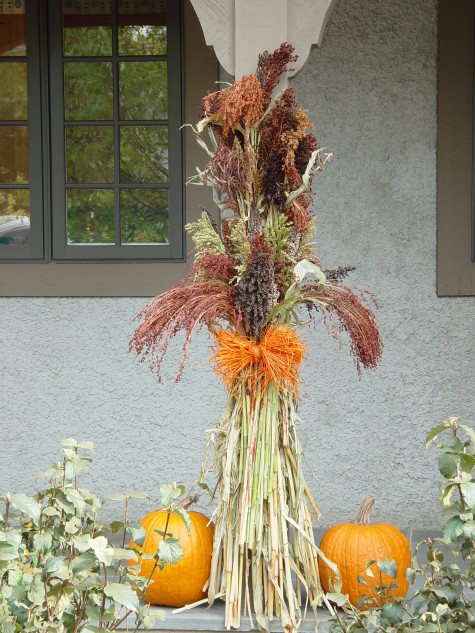 Broom corn is a plant that for hundreds of years has been cultivated for utilitarian purposes. A corn broom-do you not have one? Fresh broom corn is beautifully multicolored-some stems are droopy-others upright. A giant tie of orange raffia ties this entire arrangement to a porch pillar. Seeding broomcorn stems and stalks-this is my late October fireworks.
Broom corn is a plant that for hundreds of years has been cultivated for utilitarian purposes. A corn broom-do you not have one? Fresh broom corn is beautifully multicolored-some stems are droopy-others upright. A giant tie of orange raffia ties this entire arrangement to a porch pillar. Seeding broomcorn stems and stalks-this is my late October fireworks.
 I used to finish all of my carvings like they might be cited by the Library of Congress-no more. The truth of the best part of Halloween-a loose and fast gesture will do just fine. Buck and I so enjoy Halloween-as we have hundreds of visitors. They never critique my decor. My Halloween at home is all about meeting kids, photographing their costumes, sending them out into the night with some decent chocolate. I meet, see, and talk to every kid living in my community but once a year-Halloween night.
I used to finish all of my carvings like they might be cited by the Library of Congress-no more. The truth of the best part of Halloween-a loose and fast gesture will do just fine. Buck and I so enjoy Halloween-as we have hundreds of visitors. They never critique my decor. My Halloween at home is all about meeting kids, photographing their costumes, sending them out into the night with some decent chocolate. I meet, see, and talk to every kid living in my community but once a year-Halloween night.
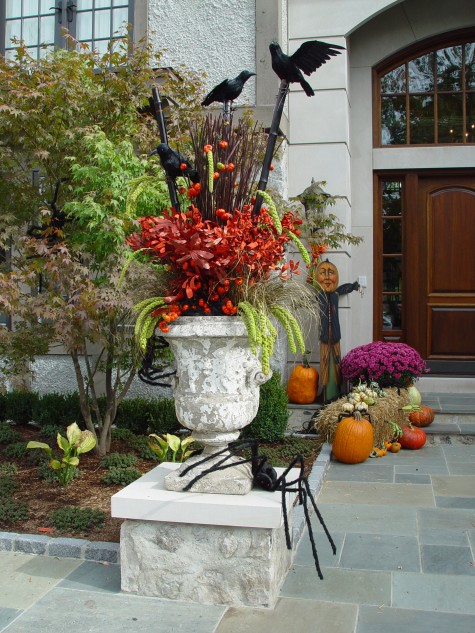 Gardening is an obsession, a serious business, an organizing metaphor for a life. I could go on, but this is Halloween weekend. I would turn everything over to those kids for this weekend. Who knows how many of them might might grow up to be gardeners-growing their own pumpkins for their kids to carve.
Gardening is an obsession, a serious business, an organizing metaphor for a life. I could go on, but this is Halloween weekend. I would turn everything over to those kids for this weekend. Who knows how many of them might might grow up to be gardeners-growing their own pumpkins for their kids to carve.
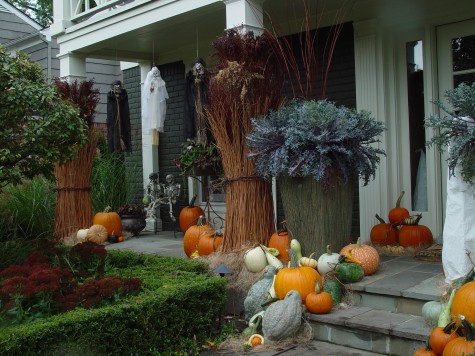 I feel really confident that gardeners all over my area have decorated from the garden, and from the plastics industries- and are ready for Halloween just like me. Sunday night, Buck and I will be ready. I cannot entirely explain why we both enjoy Halloween so much-but fun has a lot to do with it.
I feel really confident that gardeners all over my area have decorated from the garden, and from the plastics industries- and are ready for Halloween just like me. Sunday night, Buck and I will be ready. I cannot entirely explain why we both enjoy Halloween so much-but fun has a lot to do with it.
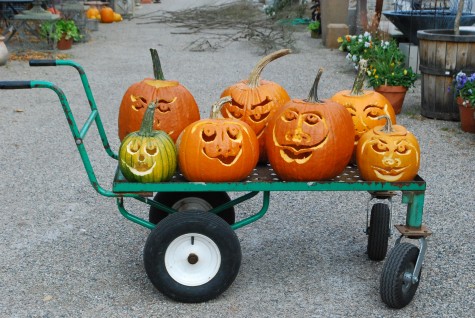 A love of the garden can be satisfying in ways I never imagined in advance. I anticipate, and plan to enjoy my Halloween. I am hoping you will have an equally horrible holiday.
A love of the garden can be satisfying in ways I never imagined in advance. I anticipate, and plan to enjoy my Halloween. I am hoping you will have an equally horrible holiday.
The Perennial Border
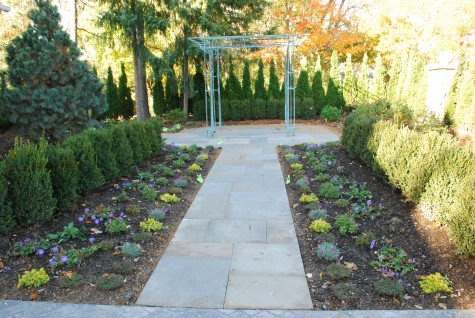 Just the words perennial border are enough to evoke visions of classical English gardens-breathtaking in width, and astonishing in length. Lavish. Believe me, if I could, I would have one, or five or twenty perennial borders each the size of a landing strip. Big enough to grow stately stands of every perennial I took a fancy to. There would be room for everything, from alchemilla to verbascum; I would winter giant tubs of Zantedeschia Aethiopica in number 6 loggia. I would grow peonies like crops. I would enlarge every and any border, on the slightest whim. I would have acres in meadow studded with fruit trees, and a wildflower garden the size of a football field. I would have a giant barn for tools, and a lunchroom that could comfortably seat the fifty gardeners I would need to have help me maintain it all. But my reality is much more about small urban gardens; these perennial gardens ask for some solid dreaming attended by careful editing.
Just the words perennial border are enough to evoke visions of classical English gardens-breathtaking in width, and astonishing in length. Lavish. Believe me, if I could, I would have one, or five or twenty perennial borders each the size of a landing strip. Big enough to grow stately stands of every perennial I took a fancy to. There would be room for everything, from alchemilla to verbascum; I would winter giant tubs of Zantedeschia Aethiopica in number 6 loggia. I would grow peonies like crops. I would enlarge every and any border, on the slightest whim. I would have acres in meadow studded with fruit trees, and a wildflower garden the size of a football field. I would have a giant barn for tools, and a lunchroom that could comfortably seat the fifty gardeners I would need to have help me maintain it all. But my reality is much more about small urban gardens; these perennial gardens ask for some solid dreaming attended by careful editing.
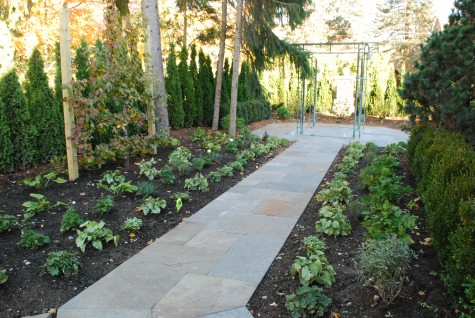 This very small L-shaped garden will very much have the feeling of a large garden, as big percentage of the square footage of the yard is devoted to perennials. The house has something of a feel of a cottage, so though the planting is regular, the plant varieties are placed in casually determined numbers. Towards a good, but not fixed, beat. The house is a very beautiful blue grey color; my first editing step was to consider color. The major tree in the yard-pinus flexilis “Vanderwolf’s”; the needles are distinctly blue. An underplanting of hosta krossa regal is a contrast in texture with much the same color. A blue hybrid of Panicum Virgatum will back up and loosen up the Carefree Beauty roses. The intersection of the bluestone walk is marked by a terrace, and a copper pergola blue with age. The blues rule here.
This very small L-shaped garden will very much have the feeling of a large garden, as big percentage of the square footage of the yard is devoted to perennials. The house has something of a feel of a cottage, so though the planting is regular, the plant varieties are placed in casually determined numbers. Towards a good, but not fixed, beat. The house is a very beautiful blue grey color; my first editing step was to consider color. The major tree in the yard-pinus flexilis “Vanderwolf’s”; the needles are distinctly blue. An underplanting of hosta krossa regal is a contrast in texture with much the same color. A blue hybrid of Panicum Virgatum will back up and loosen up the Carefree Beauty roses. The intersection of the bluestone walk is marked by a terrace, and a copper pergola blue with age. The blues rule here.
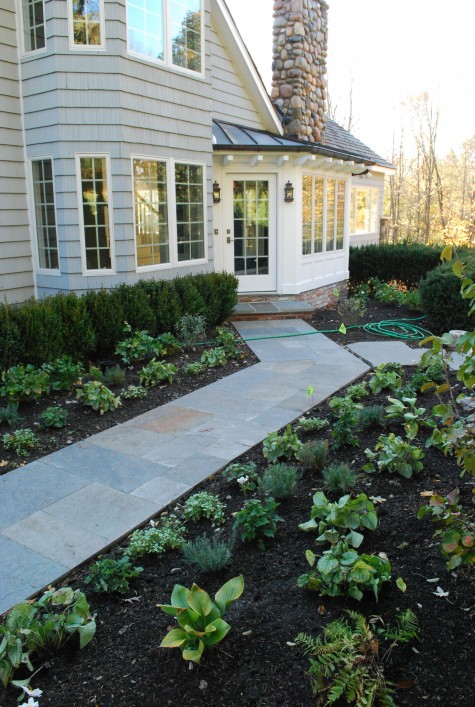 The west border is frosty in color; Jack Frost brunnera, Lamium white Nancy, Japanese painted ferns, white Japanese anemone; I threw in a few flax and Salvia May night in the sunniest and driest spots. This border may not be 10 feet deep, but relative to the overall space, the borders are generously configured.
The west border is frosty in color; Jack Frost brunnera, Lamium white Nancy, Japanese painted ferns, white Japanese anemone; I threw in a few flax and Salvia May night in the sunniest and driest spots. This border may not be 10 feet deep, but relative to the overall space, the borders are generously configured.
 The star of the west border-a Bradford pear trained as a espalier. It is an old plant, but the branches are not yet sturdy enough to maintain their shape without a form. The posts will be stained the same color as the house. Providing privacy in the yard is the arborvitae “DeGroot’s Spire”. The small and fine texture of the needles is appropriate for a small space. Once they establish, I will prune off the spire part. This arborvitae takes well to a geometric pruning. I would like to see them kept at 10 feet with a flat face-a green wall.
The star of the west border-a Bradford pear trained as a espalier. It is an old plant, but the branches are not yet sturdy enough to maintain their shape without a form. The posts will be stained the same color as the house. Providing privacy in the yard is the arborvitae “DeGroot’s Spire”. The small and fine texture of the needles is appropriate for a small space. Once they establish, I will prune off the spire part. This arborvitae takes well to a geometric pruning. I would like to see them kept at 10 feet with a flat face-a green wall.
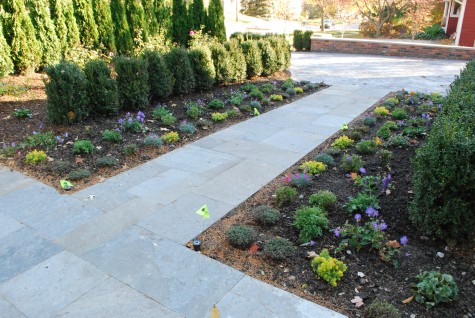
The north walk off the drive is home to two generously wide perennial borders, enclosed by a tall hedge of Green Mountain boxwood. These borders feature Salvia May Night, a dwarf monarda and geranium Rozelle; the remaining space is given to a mix of angelina, dianthus and thyme. Wide and low, this border will feature the ground plane, and make the space look spacious. On the far side of the drive, limelight hydrangeas and Venus dogwoods will make the garden entirely private from the neighboring house.
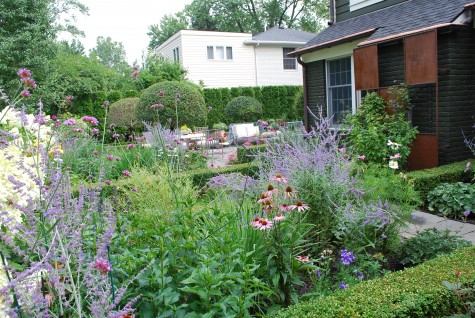 Perennial borders occupy a lot of space at maturity. A new garden with tall perennials is guaranteed to look sparsely planted the first year, and stuffed the third year. That big and wild look can warm up a small space like nothing else can. I always find someplace to plant a few verbena bonariensis-so the big garden looks airy, and not heavy.
Perennial borders occupy a lot of space at maturity. A new garden with tall perennials is guaranteed to look sparsely planted the first year, and stuffed the third year. That big and wild look can warm up a small space like nothing else can. I always find someplace to plant a few verbena bonariensis-so the big garden looks airy, and not heavy.

When your John Cabot rose gets to this age, changes have to be made. I planted this rose 20 years ago; this perennial garden has changed dramatically over the years. Some perennials faded-some thrive. The trees have changed the pattern of sun and shade as they have aged. Unlike a tree, a perennial garden changes dramatically over that length of time. Given this volatility, I try to edit in favor of perennial plants with a propensity to be healthy; long season interest, good habit, interesting foliage and reasonable maintenance, and reliable bloom count for a lot too. There are good reasons not to plant plenty of perennials, should your space be really small. That said, there will likely be room for those perennials that only pass the “I cannot live without it” muster; why do without them?
1-800-Call-Linda
Though I do not talk about it much, a considerable amount of my time is spent as an administrator. Though I would much rather be designing anything-a topiary sculpture, a series of containers, a pergola, flowers for a wedding, a series of steel pots, a landscape, a vignette in the shop, a perennial garden, I am in fact a small business owner. My simple version of what business ownership means to me can be summarized as follows. My love of landscape and gardens, my interest in people who have the inclination to garden, my need to create-my plan is that my business enchants my clients, and sustains the evolution and expression of my entire group.
Sustenance is a word fraught with meaning to every gardener. Healthy soil sustains everything that roots into it. Countless plants provide sustenance-grapes, tomatoes, chard, cauliflower, potatoes, corn. The farmers in this country feed lots of people-I am grateful to them for the cippolini onions, garlic, chard, beet greens and tomatoes I bought last Saturday at market. Sufficient water encourages new trees and shrubs to root. I am particularly interested in my clients having success with their landscapes, their gardens, their pots, as I know they will get sustenance of some kind from it if they stick with it.
I am sustained in no small part by my banker Linda Saperstein. For years she has made the administration of my business easier via National City Bank. I am a very small business, but she has always treated me with spot on attention and respect. NCB has now become PNC bank- she did not skip a beat. I got lots of help from her, handling that change. I had a letter/question from the bank; call our 800 number, it said. 20 unsuccessful minutes later, I called Linda. Never call the PNC 800line, she tells me today. That’s what I’m for. Call 1-800-Linda, ok? She not only handled my request, she made me laugh.
I have been thinking about her all day. I love how willing, able and available she is. Our European shipper will collect everything Rob purchased; Linda electronically transferred the funds needed to their bank. The process of collection, packing and shipping from overseas begins when the shipper has the funds to pay Rob’s bills. Linda made that happen with dispatch. Should you be interested in a banker who answers her phone and knows your name, call Linda Saperstein at PNC Bank. As far as I am concerned, PNC Bank’s real name is Linda Saperstein.


